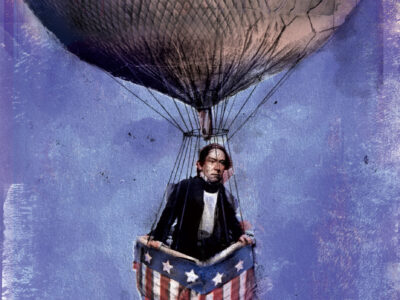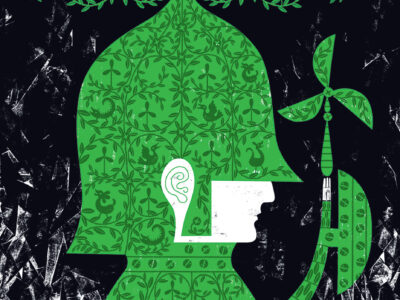
Some portrait artists like to be on a first-name basis with their subjects, and Emma Schachner is one of them—even if she has to make up the name. Such was the case with a recent visitor from Yale’s Peabody Museum of Natural History. He’d come in pieces in a FedEx box, as brittle as 220 million years can make something, but he looked like a Brutus. So that’s what Schachner called him as she carefully drew his veins and bones freehand with pencils and inks. Otherwise known as Poposaurus gracilis, a crocodilian from the Late Triassic Period, her subject demanded something more intricate than computerized drafting tools. That’s why the specimen had found its way to her.
Schachner, a PhD candidate in paleontology, is one of a small group of paleontological illustrators, a valuable skill in the world of dinosaurs and fossils. Researchers at Yale are counting on her to get Brutus’s every vein and crevice just so, the old-fashioned way, by hand.
“In papers describing an animal, they usually have pictures that are either photographs or illustrations, but illustrations are vastly superior,” says Schachner. “A fossil a lot of times has cracks or matrixes [to hold the fragments in place]. When you take a photograph, the lighting can highlight those things unnecessarily. When you illustrate them, you can ignore [those things] and concentrate on what is more important—some scientific things that are important to highlight. You can show depth. It takes a long time, but it is well worth it in our field.”
Schachner comes to her specialty part by heredity and part by serendipity. Her mother, Jane, is the author and illustrator of the Skippyjon Jones children’s book series.
“My mom used to put up big rolls of paper on all the walls so we could draw on them when we were little kids,” Schachner recalls, noting that her parents also indulged her craving for dinosaur toys and statues when she was young.
Near the end of her undergraduate studies at Bucknell, where she played lacrosse and studied political science, she was trying to figure out what to do after graduation when she met with family friend and fellow dinosaur enthusiast Bill Pinder, manager of the Swarthmore College greenhouse. Pinder introduced her to people in the local paleontological community and soon she decided to join them. She enrolled in a master’s program at the University of Bristol in England—“A boot camp for paleontologists,” she says—and then came to Penn to study under Peter Dodson, a professor of anatomy at the Veterinary School, who also teaches paleontology in the College’s Department of Earth and Environmental Science.
“The typical scientist does not do his or her own drawing, and the ones who do, like Emma, have a powerful tool at their disposal,” says Dodson. “There is a saying that the person who sings prays twice. Well, the person who draws does science twice.”
Schachner says illustrating makes paleontology more vital for her.
“It is a totally different intellectual experience. It feels like a different part of the brain,” she explains. “I feel it helps me look at the fossil in greater detail, because I spend at least 12 hours drawing it. I am staring at that fossil under different light, and I am translating it onto paper. When you go and try to write about it, you haven’t overlooked anything.”
Schachner’s research centers on ancient archosaurs, a group that includes crocodiles and birds. Her doctoral work focuses on their respiratory biology and musculature. “There aren’t many people studying what I do,” she says, “and then, since there may only be about 10 or a dozen people who illustrate and are actual researchers, we are part of a small paleo-art world, too. We will never know everything about ancient life, but each time I find something about a crocodile, for instance, it seems exciting.”
In the dinosaur realm, Schachner’s favorite is the same one she had a crush on as a little kid: Deinonycus, a small velociraptor, one of which is mounted at the Academy of Natural Sciences in Philadelphia.
“It’s the animal the raptors in Jurassic Park were based on,” she says. “When I was a girl, he was just my size, but with a claw and a tail. It was a dream dinosaur and I’m ecstatic I’m able to play every day in my childhood dream.”
—Robert Strauss




